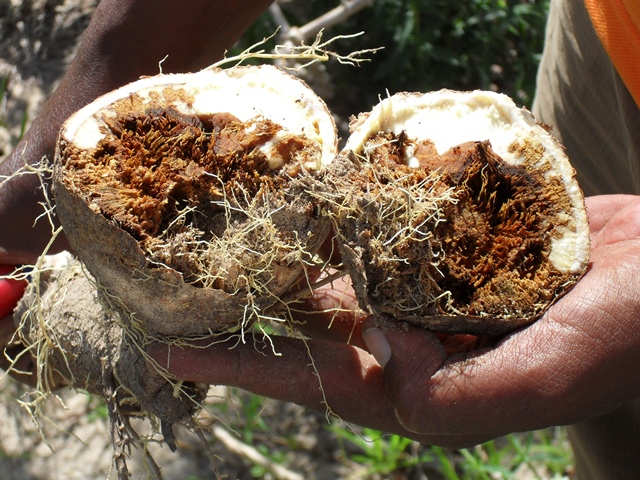
Cassava roots affected by cassava brown streak diseases – the linkage map will help scientists in their efforts to develop varieties resistant to this and other deadly diseases. Photo by J. Legg
A high-resolution linkage map and chromosome scale-genome assembly for cassava by a group of international researchers, including some from IITA, has been published in G3 Genes Genomes Genetics, and highlighted by the Genetics Society of America (http://www.g3journal.org/content/5/1/133.full).
The linkage map was generated by combining 10 genetic maps from 14 diverse parents from African cassava breeding projects including those of IITA in East Africa and Nigeria. It was a collaborative effort aomg researchers from IITA, the Agricultural Research Institute (ARI) of Tanzania, National Crops Resources Research Institute (NaCRRI) in Uganda, National Root Crops Research Institute (NRCRI) in Nigeria and the University of Berkeley/ Joint Genome Institute, USA.
It was accomplished through two collaborative projects funded by the Bill & Melinda Gates Foundation. One of them, administered by IITA, focuses on the development of mapping populations, and the other, by University of Arizona, focuses on improving the cassava genome sequence.
According to Dr Morag Ferguson, IITA’s Cassava Molecular Geneticist, the maps have allowed the aligning of DNA sequence fragments into larger fragments or scaffolds, so that now 90% of the cassava genome assembly is contained in only 30 large fragments, whereas previously it was made up of approximately 13,000 pieces.
“This will be a valuable tool in a number of research areas from diversity assessments to functional genomics and will ultimately assist researchers to efficiently identify and use genetic variation for improved productivity, disease resistance, enhanced nutrition and to develop varieties for industrial processing amongst other applications,’ she said.
This is good news for small-holder farmers in sub-Saharan Africa where currently the crop’s production is greatly threatened by two viral diseases, cassava mosaic disease (CMD) and cassava brown streak disease (CBSD).



No Comments